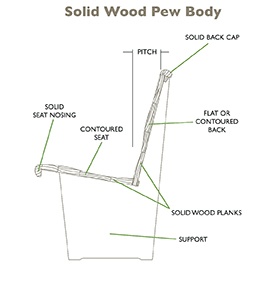
 Ergonomics isn’t just for scientists and designers — it’s an integral part of choosing the right seats for your worship space.
Ergonomics isn’t just for scientists and designers — it’s an integral part of choosing the right seats for your worship space.
By Amanda Opdycke

In seating manufacturing, Ergonomics is an integral element of the design and development process. Combined with the study of Anthropometry — the science that measures the range of the body size within a population — Ergonomics allows for maximum achievement of comfort in any number of seating products. These concepts are collated to create a superior level of comfort in pews, chairs or auditorium seating.
The following details are important to consider as you begin the daunting task of determining not only what seating will enhance your worship experience, but also the level of comfort needed for the congregation to best understand God’s message.
Ergonomics: not just numbers and statistics

Ergonomics are more than facts and figures gathered to assist in the creation of various types of seating. Rather, the study of Ergonomics provides comfortable seating that allows the congregation to fully enjoy the sermon — the primary purpose of the worship experience.
Parishioners are coming to experience the Word of the Lord. If they are fidgeting in their seats, they are no longer
focused on the Word, but on their discomfort in the seats … and how quickly they are able to get out of them.
This leads to a vital element of Ergonomics: design. When selecting sanctuary seating, it is important to consider comfort. Maximum comfort can be achieved when the spine is in a neutral position, similar to standing. A seated lumbar support helps in the continuation of the “S” curve shape of the spine. The construction of the seat itself is far more important than the “cushy” feel of the foam and fabric. While the latter elements are important, too, it is wise to understand the structural elements of construction.
Best practices and comprehensive research will be helpful as you look for a seat that is designed to fit the contour of the upper legs through the lower back. If the seat pan is too shallow, it will cause serious discomfort behind the knees. This, in turn, impacts the pressure points behind the knee.
Another seat design element to keep in mind is the structure of the seat from the front to the back. Not including a contoured seat to support the contour of the leg will result in leg and back pain. Some manufacturing processes do not include a contoured seat to support the contour of the foam.
A contoured seat structure supports the contoured 
foam; this means that as foam naturally degrades over time, the base structure will continue to support the natural curvature of the lower body. This results in extended comfort over the life of your seating.
A final component of seat comfort is the height of the seat. If the seat is too high, this too will create discomfort in the legs.
We often think of the back when we think of Ergonomics. This is a critical part of the equation — but not as critical as one might think.
It is often the case that the foundation of our seat is directly related to the comfort of the back. As previously stated, the design of the back should support the design of the seat. There are a number of elements that will contribute to back comfort. The pitch of the back will directly impact the level of comfort. The lower the incline of the back pitch, the less comfortable the back will be. Another detail to keep in mind is the lower-back contour. As you try out different types of seats, it is important to notice how the lower back contour couples with the contour of your back.
The simplest advice of all: sit!

When selecting worship seating, bear in mind that actually sitting in the seat might be the most crucial aspect of your decision process. If possible, try out the seats over the course of a short period of time. Determine if the seats will suit your ultimate goal: maintaining attentive comfort as a means to engage your parishioners with God’s word.
Amanda Opdycke is Worship Market Manager at Sauder Worship Seating in Archbold, OH.


